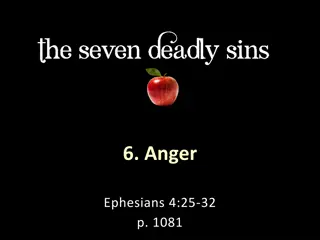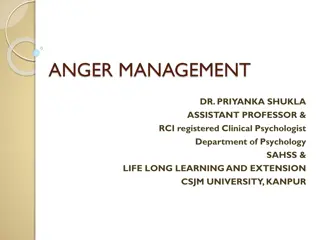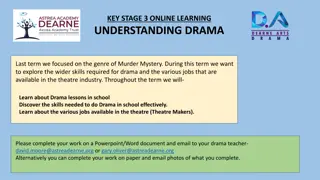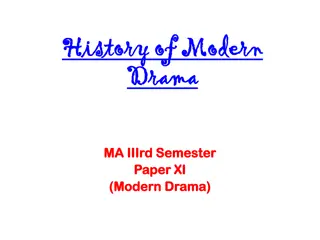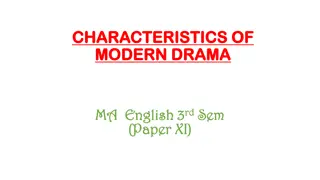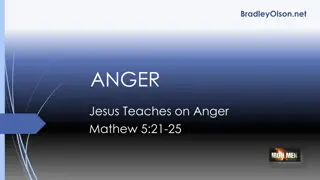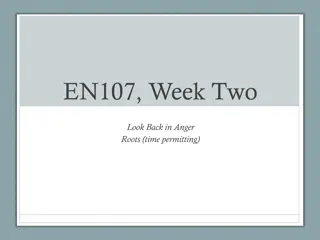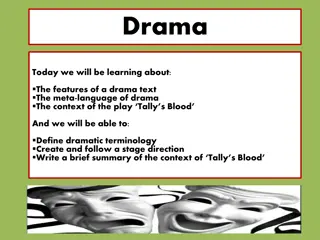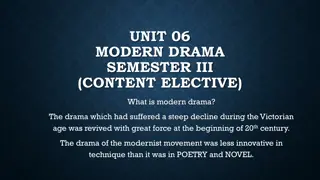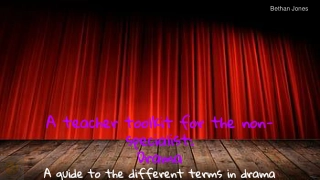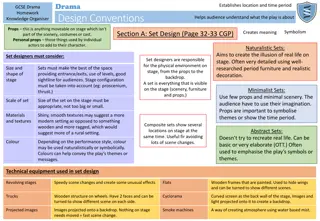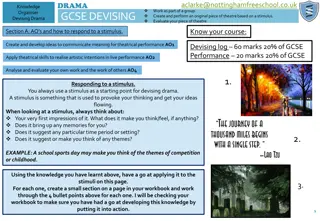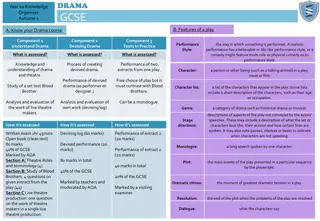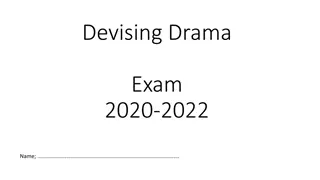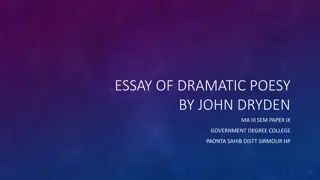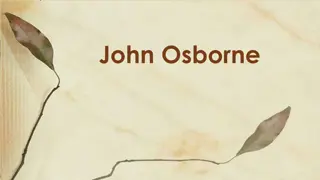Exploring John Osborne's Look Back in Anger: A Modern Classic Drama
Look Back in Anger, a seminal play by John Osborne, delves into themes of alienation and identity in post-World War II England. The play's protagonist, Jimmy Porter, embodies the disillusionment and rage of the era, challenging societal norms and class struggles. Osborne's work revolutionized English theatre, influencing modern character archetypes and narratives. Through a bleak yet introspective lens, the play prompts audiences to contemplate the complexities of human nature and societal change.
Download Presentation

Please find below an Image/Link to download the presentation.
The content on the website is provided AS IS for your information and personal use only. It may not be sold, licensed, or shared on other websites without obtaining consent from the author. Download presentation by click this link. If you encounter any issues during the download, it is possible that the publisher has removed the file from their server.
E N D
Presentation Transcript
CC 11 Semester - III Look Back in Anger Dr. Md Naushad Alam Dr. Md Naushad Alam Assistant Professor P. G. Dept. of English MMHAPU
John Osborne John Osborne was born in southwest London to lower middle class parents, a barmaid and an advertising copywriter. His father died in 1941, when Osborne was twelve. Osborne briefly attended a public (non state-run) high school, but was expelled after two years when he struck a school administrator who had tried to discipline him. He wrote his first play at the age of twenty-one, in 1950. Around that time, Osborne with the actress Pamela Lane. Look Back in Anger is loosely based on their tumultuous relationship. Osborne wrote it in 17 days while on vacation, and it was first produced in 1956. The production catapulted the 26-year-old Osborne to fame, and ushered in a new era of British theatre showcasing working class protagonists in the contemporary, post-World War 2, era. Osborne went on to write many more plays and a two- volume autobiography (in which he reveals a vehement dislike for his mother). Osborne married five times, ending his life happily married to the art critic Helen Dawson. He died in 1994 due to complications from diabetes. His last word, to Dawson, is said to have been sorry. Look Back in Anger remains by far his most famous work. John James Osborne was an English playwright, screenwriter and actor, known for his excoriating prose and intense critical stance towards established social and political norms. The success of his 1956 play Look Back in Anger transformed English theatre. Born: 12 December 1929, Fulham, London Died: 24 December 1994, Clun, United Kingdom Spouse: Helen Osborne (m. 1978 1994 Children: Nolan Osborne Awards: Tony Award for Best Play (Source *Wiki)
Look Back in Anger: Introduction Look Back in Anger is a play about alienation and identity in 1950s England. The play was considered modern for its time, and upended the theater world with its bleak portrayal of Jimmy Porter as an everyman with nothing going for him but his ideals, ideals packaged in rage and anger. Audiences were devastated by the play, but this devastation and an intimate glimpse of real struggle in the face of a changing world, a world where one had no agency, garnered praise from critics and viewers alike. The role of Jimmy Porter has been noted as the archetype for many modern-day characters. These male characters often operate with dubious methods despite having supposed hearts of gold, or at least intentionally bury their feelings. Marlon Brando s Stanley in A Streetcar Named Desire is one example of this troubled character type making inroads into theater and literature.
Look Back in Anger is divided into three acts and, in its structure, mirrors earlier works by playwrights like Ibsen. The beginning of the first and third act mirror each other, indicating to the reader or viewer that things might seem to stay the same but ultimately change. This lack of morals, or lack of beliefs, underscores the theme of alienation and identity found throughout the play. The play takes place after WWII, and England is still reeling from the effects of that war, in addition to changing social beliefs. The social microcosm of the Porter s attic flat in the Midlands is symbolic of a larger English struggle at the time in the face of helplessness, loneliness, general apathy, and death. The play challenges readers to explore preconceived notions of heroes, heroines, good, and evil. The play s class struggles and personal struggles allow readers or viewers to ponder who really wins and who loses by the end of the play. The play is set in the present, yet the undeniable past informs each character. The past highlights each character s dreams and desires, yet hides any readily available notions of what the future might hold for them.
Look Back in Anger: Character Jimmy Porter Jimmy Porter is the play s main character. He is the Angry Young Man who expresses his frustration for the lack of feelings in his placid domestic life. Jimmy can be understood as both a hero for his unfiltered expressions of emotion and frustration in a culture that propagated unemotional resignation. He can also be considered a villain for the ways in which his anger proves to be destructive to those in his life. Cliff Lewis Cliff is a friend to both Jimmy and Alison. Cliff lives with them in their attic apartment. He is a working class Welsh man and Jimmy makes sure to often point out that he is common and uneducated. Cliff believes this is the reason that Jimmy keeps him as a friend. He is quite fond of Alison and they have a strange physically affectionate relationship throughout the play. Alison Porter Alison Porter is Jimmy s wife. She comes from Britain s upper class, but married into Jimmy s working class lifestyle. The audience learns in the first act that she is pregnant with Jimmy s child. Jimmy s destructive anger causes her great strain and she eventually leaves him. Her child miscarries and she comes back to Jimmy to show him that she has undergone great suffering.
Helena Charles Helena Charles is Alison's best friend. She lives with them in their apartment while visiting for work. Helena is from an upper class family. She is responsible for getting Alison to leave Jimmy. She and Jimmy then begin an affair. Her sense of morality leads her to leave. She can be considered the play's moral compass. Colonel Redfern Colonel Redfern is Alison's father. He represents Britain's great Edwardian past. He was a military leader in India for many years before returning with his family to England. He is critical of Jimmy and Alison's relationship, but accepts that he is to blame for many of their problems because of his meddling in their affairs. Hugh Tener Jimmy s friend, who took Alison and Jimmy into his apartment in the first months of their marriage. He was Jimmy s partner when they went on raids against Alison s upper class friends at fancy parties, and Jimmy saw him as a co-conspirator in the class struggle. Mrs. Tener The mother of Hugh Tanner, called Hugh smum by Jimmy, she helped set Jimmy up with his sweet stall. Jimmy loves her, andAlison thinks this is just because she is lower class and ignorant.
Look Back in Anger: Short Synopsis Look Back in Anger is a searing, jolting look at class, sex, politics, and the stifling conventions of 1950s England, all lamented by voices of the angry, alienated youth living at its margins. The champion of the angry young men is Jimmy Porter: proud, educated, lower-class, and volatile. He lives in a one-bedroom flat with his wife, Alison. Alison represents all that Jimmy stands against; she is upper-class, privileged, and detached. There exists a passion between the two that neither can live with nor without. It is left to their roommate, Cliff, an affable young Welshman, to keep some peace within the household. Into this time bomb walks the affluent, upright Helena Charles, an old friend of Alison s, from her former life. As the four fight each other, fall in and out of love, and release their pent-up rage towards the outside world, the audience receives a glimpse into playwright John Osborne s frustrated, class-choked world. Jimmy laments. The wrong people going hungry, the wrong people being loved, the wrong people dying!
Look Back in Anger: Plot Look Back in Anger Presents everyday domestic scene Jimmy Porter is at home on Sunday in his tiny one-bedroom flat, reading newspapers and chatting with his friend Cliff. Jimmy s wife Alison is doing the ironing. Jimmy is from a working-class background (he owns a stall selling sweets), while Alison is from an upper-class family and Jimmy hates her for this. Jimmy and Cliff play-fight and knock over the ironing board, leading Alison s arm to get burnt by the iron. Jimmy goes out and Cliff stays to comfort Alison. Alison confides that she is pregnant but is scared to tell the mercurial Jimmy. Jimmy comes home and he and Alison make up, playing a game they call bears and squirrels . A friend of Alison s named Helena rings, and Alison invites Helena to come and stay with them, which angers Jimmy so much that he says he longs for something to wrench his wife out of her beautysleep even the death of her own child (remember that he s unaware at this stage that she is actually pregnant). When Helena comes to stay, Jimmy is rude to both her and to his wife (again). Jimmy receives news that his friend s mother is dying, he asks Alison to go with him to London to visit her. Alison says no.
. Plot Continue Jimmy goes to London on his own, and when he gets back his wife is away. Helena is still there, and the two of them have a row, before Helena seduces Jimmy. Helena hands Jimmy a note from Alison informing him that she is pregnant with his child. We then move forward several months. Once more, it s a Sunday. The scene is much the same as it was at the beginning of the play, except this time it s Helena doing the ironing. Alison turns up, and while Jimmy is out of the room, she reveals that she lost the baby. Helena breaks up with Jimmy, and Jimmy and Alison are reconciled once more. The play ends with them playing another round of bears and squirrels . Look Back in Anger is as likely to remind us of the other side to the 1950s, if anything reminding us that post-war life was pretty wretched for many women in the years before the arrival of the permissive society in the late 1960s, and that the kitchensink and the ironing board were seen as their rightful place by many men (and many women, too, we daresay).


